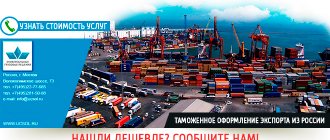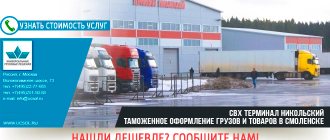Customs Delivery Certification Labeling Inspection Customs representative services AEO services Price list and contracts
When importing goods into the territory of the EAEU, all goods are subject to customs clearance, after successful completion of which they are released for sale on the territory of the Union. However, there are situations when the release of goods as usual is impossible. In this case, the declarant has the right to take advantage of the opportunity to release the goods conditionally.
Conditional release of goods is a two-stage option for completing the release procedure for domestic consumption, if it is impossible to release goods into free circulation on the territory of the Union. Upon conditional release, the importer undertakes the following obligations:
- on compliance with restrictions on the use of goods, including;*
- upon submission of the necessary documents and information;
- for payment of customs duties.
*During the period of conditional release, a number of restrictions are applied to goods: their sale and transfer to third parties is prohibited until the customs authority makes a decision on compliance with prohibitions and restrictions and release for domestic consumption.
Conditionally released goods can only be located on the territory of the state in which the release took place.
For which products does conditional release apply?
According to customs legislation (Article 126 of the EAEU Labor Code and Article 111 of Federal Law No. 289), conditional release is applied for goods placed under the procedure for domestic consumption, in respect of which:
- benefits for the payment of customs duties have been applied or rates of import customs duties are lower than those established by the EAEU CCT;
- compliance with prohibitions and restrictions can be confirmed after the release of goods;
- permitting documentation is required;
- Components of goods that are imported in separate shipments in an unassembled or disassembled form, including incomplete or unfinished form, are also considered conditionally released.
Terms and cost of processing product samples for certification and testing at customs
The deadline for processing product samples at customs for certification is 1 day!
At the same time, the price or cost of customs clearance services - “customs clearance” of imported product samples for certification and testing in our company is the minimum in the market and depends on the place of customs clearance and the tasks set by the participant in foreign trade activities, on average it can be:
- Legal entity or individual entrepreneur - 5,000 - 15,000 rubles.
Grounds for permitting conditional release of goods
Customs authorities have the right to authorize the conditional release of goods only upon a reasoned request from the declarant. The appeal is submitted to the customs authority in written or electronic form.
The appeal must contain the following information:
- an objective reason for the failure to submit permits or the absence of mandatory EAC marking;
- name and location of the addressee of the goods;
- information about the characteristics of goods for which there are no permits;
- information about the country of departure (manufacturing) of the goods;
- name and address of the place where goods are stored, documents confirming the right of ownership or use of the premises, as well as conditions for storing goods;
- deadline for submitting documents, but not more than 45 days.
If the declarant fails to provide all necessary documents, the customs authority has the right to refuse release.
Customs clearance of product samples for certification
Ours is a customs broker (representative) and deals with customs clearance, “customs clearance” when importing product samples for certification and testing at any customs offices of the Russian Federation:
- At airports
- In seaports
- At railway stations
- At cargo automobile terminals – temporary storage warehouse
- Express postal items
If necessary, we carry out customs clearance of samples for export or in any other customs procedures!
We work with any participants in foreign trade activities:
- Individuals
- Legal entities
- Individual entrepreneurs
Do you need to clear product samples for certification and testing through customs? – We will help you!
Documents and information for registration of product samples for certification
- Agreement indicating the conditions for the export of goods;
- Application for the import of samples to the certifying body, with the registration number and the specified number of samples required to obtain the SGR;
- Agreement with the certification body;
- Letter for the import of samples from the certifying body for customs on the import of samples of goods for certification and testing, indicating the quantity;
- Customs declaration.
Cases of practical application of conditional release of goods
Let's look at several practical cases of applications for conditional release of goods.
Obtaining the necessary permits:
- For customs clearance of a consignment of goods that have already arrived in the territory of the Russian Federation;
- For customs clearance of a consignment of goods, samples for certification of which arrived simultaneously with the main consignment, within the framework of one international delivery.
For these categories of goods, a mandatory condition for release into free circulation on the territory of the EAEU is the availability of permits confirming the fact that the products comply with all the requirements for the quality and safety of imported products. In the absence of confirmation of compliance with the requirements of technical regulations of the EAEU, the requirements of federal services, such as the FSB. FSTEC, FSVTS or other regulatory authorities may issue a conditional release of products for a period of up to 45 days. During this period, the declarant is obliged to obtain the necessary permits and submit them to the customs authorities.
For conditional release of goods included in category 1, it may be necessary to take samples for certification and for an authorized specialist to visit the collection site. This service is provided on a paid basis.
To apply mandatory labeling to products
On the territory of the Union, a single sign of circulation on the EAEU market is mandatory for all goods - the EAC marking. In its absence, the customs authority releases goods conditionally if:
- the declarant has not been brought to administrative responsibility for offenses in the field of customs during the year;
- the declarant has submitted all necessary documents;
- the declarant is a person authorized in accordance with the law of the EAEU to apply a single circulation mark to the goods.
In all other cases, customs officials oblige the declarant to apply markings to the imported goods, placing them in a customs warehouse or temporary (confidential) storage warehouse, declaring the appropriate customs procedure.
The OnlogSystem company provides services for applying mandatory digital markings, marking goods with the EAC mark, adapting markings for the foreign market in case of export, as well as for sale on the Union market in case of import.
Import of multi-component equipment
When importing multi-component equipment or goods imported in an unassembled/disassembled form, conditional release is a mandatory condition for the fulfillment of such deliveries. He is declared along with the first DT. The motivated letter indicates all the details of the delivery being carried out, including the number of batches. Conditional release ends automatically after customs clearance of the last batch of goods.
The concept of goods in economics
Definition 1
A product is an object of relationship between the seller and the buyer, which brings benefits to both parties to the transaction.
If a good is produced for one’s own consumption, that is, it does not participate in the exchange process, then it cannot be a commodity. In the classical school of political economy, a product was considered from two sides. According to scientists, it had use value, namely, it could bring utility to the buyer. It also had exchange value. The goods were subject to exchange, which could bring the manufacturer a certain income. Marxist teaching viewed a commodity as a combination of utility and potential income for the producer. However, the value of a product was measured not by its use value, but by the amount of labor applied in the process of its creation. Marxists considered price to be the monetary expression of the value of a product or a measurement of the amount of labor applied.
Are you an expert in this subject area? We invite you to become the author of the Directory Working Conditions
Trading goods on the market involves price fluctuations. The reason is various factors affecting the market. In most cases, the price of a product exceeds the average production cost. Manufacturers have the opportunity to accumulate capital or invest it in expanding their business activities. There are situations where the price does not cover production costs. Enterprises begin to operate in the red, gradually losing their income and reserves, which leads to bankruptcy. The occurrence of such a imbalance can occur for various reasons, due to macroeconomic changes, for example, an economic crisis. Manufacturers themselves can use unfair competition to expand the sales market by applying dumping policies. Another reason for the unprofitability of products is unprofessional production management, or errors in regulating the production activities of the enterprise.
Note 1
A distinctive feature of the product is its quality. It determines the level of consumer interest. Quality is a set of consumer properties that can satisfy customers. These include such characteristics as reliability, ease of operation, convenience, ergonomics and more.
Finished works on a similar topic
Coursework Conditionally released goods 460 ₽ Abstract Conditionally released goods 280 ₽ Test work Conditionally released goods 220 ₽
Receive completed work or specialist advice on your educational project Find out the cost
Completion of conditional release of goods
In the case where conditional release is not a condition for the implementation of a multi-component delivery, it ends when the owner of the goods has fulfilled all the requirements imposed on him:
- provided the missing compliance documents confirming the quality and safety of the products;
- confirmed the customs value of the goods;
- provided confirmation of payment of customs duties;
- applied all necessary markings to the products, etc.
After this, the goods can be released into free circulation throughout the Union. Upon completion of conditional release, the goods are also released from all restrictions on use and disposal.
If you still have any questions about the conditional release of goods or
customs clearance of goods , you can contact our specialists by calling , emailing or contacting us through any convenient feedback form located on our website.
Customs regulation of trade turnover
The economies of most countries have become open to interaction with other states. All of them enter into international trade relations, which entails the exchange of goods and services. However, countries differ in their level of development, income, and availability of production factors. Most of them are involved in the international division of labor, which involves the production of those products that are most profitable from a commercial point of view. That is, the country creates goods, the production of which will cost less than global prices. Other countries where the production of a homogeneous good will be expensive and unprofitable will form a demand for it.
Not every country is able to compete in the international market. In order to protect the domestic market from imported goods, support national producers, and ensure the safety of life and health of citizens, methods of state customs regulation are used. It consists in managing the country's foreign trade activities. Regulatory instruments are procedures, duties and customs rules. The purpose of customs intervention in international trade can be called:
- Ensuring the development of the domestic market.
- Increase in revenues to the state budget.
Most often, customs tariffs are used to manage the flow of goods. They represent a direct administrative impact on international relations. In order to formalize the transportation of goods, customs declarations are used, which contain all the comprehensive information that allows you to calculate the tariff for a specific product.
Note 2
Customs regulation is often used as a tool for political influence on the economy. In the modern world, it is not uncommon for customs wars to break out between countries. Managing customs tariffs has a positive impact on the development of the domestic economy. It can stimulate the development of certain sectors of the national economy, which for some reason cannot compete with import producers.








